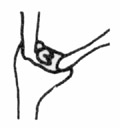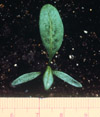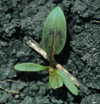Pennsylvania Smartweed (Polygonum
Pensyvanicum)
Ladysthumb (Polygonum Persicaria)
Swamp Smartweed (Polygonum coccineum)
Smartweed Species-Group
Smartweed Family
Pennsylvania smartweed and ladysthumb are difficult to
differentiate. In Iowa, we have almost all Pennsylvania smartweed, so that part is easy.
Many are taught that ladysthumb has the purple "ladysthumb" spot on the leaf,
but I have seen so many Pennyslvania smartweed plants (using all the other features) with
the spot that I wouldn't rely on that feature. This is a demonstration of the first
principle of weeds, biodiversity. It might also indicate cross-fertilization, I am not
sure. The best way to separate these two species is by hairs on the ochrea.
 Here (left) is Pennsylvania smartweed in flower
interfering in Michigan barley field.
Here (left) is Pennsylvania smartweed in flower
interfering in Michigan barley field.
Another robust Pennsylvania smartweed: 
 A young ladysthumb plant with the distinctive purple
thumb mark (left).
A young ladysthumb plant with the distinctive purple
thumb mark (left).
Biodiversity in weeds leads to many forms of a plant and plant parts. On the left are
leaves of ladysthumb, on the right leaves of Pennsylvania smartweed. Notice the different
sizes. This could be due to growth conditions (Plasticity: more water and light and
nutrients, the bigger the leaf), or it could be developmental leaf differences encoded in
the plant genes (somatic polymorphism, a big word for many forms of a plant).


Ochrea & Stems (remember this from the broadleaf
weed ID toolkit?)


ladysthumb  Pennsylvania
smartweed
Pennsylvania
smartweed 
Seed & Seedlings
Pennsylvania smartweed Seed
Notice the small seedlings on the right side of the right picture (photo credit to Dr.
David Staniforth).


Pennsylvania smartweed Seedlings




Flower color in both varies from white to pink to rose to
purplish. The color of the variant within the species or species-group is not determined
by environment, and is a good example of polymorphism within a species or species-group.
If different colored flowers occur within the same genotype (probably less likely) it
would be somatic polymorphism. More likely, the different colored flowers are a reflection
of genetic polymorphism with a species or species-group.
ladysthumb 

Pennsylvania smartweed 

Swamp smartweed:
Seedhead, with purple flowers:





